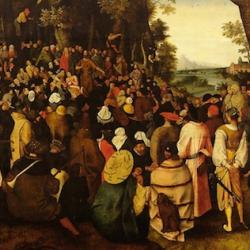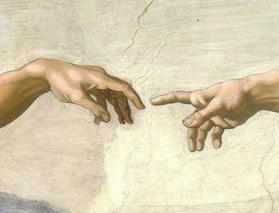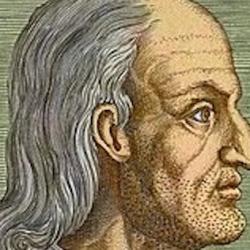This is the first of what may turn out to be (but also may not turn out to be) a series of outlines or summaries of David Bentley Hart?s Beauty of the Infinite . My goal in this outline (or, these outlines) is not to critique Hart so much as to understand him. This is an outline of the Introduction to the book.
I. The Question
Here Hart describes his project as a defense of the inherent aesthetic appeal of Christian rhetoric. Christianity claims that the peace of Christ has entered into time, and this claim is made a ?real and available practice?Ein the church. Thus, it is the church that gives meaning to the gospel, as the ?form of Christ?Eis ?lived out in the community of the church . . . only if Christ can be practiced is Jesus Lord.?E
This Christian claim stands in contrast to the contemporary post-Nietzschean claim that violence is inescapable, and that all rhetoric is violent. A rhetoric of peace is not really that, but merely duplicitous: ?subjected to a thorough critique, genealogy, or deconstruction, evangelical rhetoric can undoubtedly be shown to conceal within itself the most insatiable appetite for control.?EThe church?s witness is for this line of thought ?in reality an aggression, the ingratiating embassy of an omnivorous empire.?EIf this postmodern perspective is true, then Christianity faces an inherent contradiction between the content of its claims (the church is the earnest of eschatological peace) and the form of its persuasion (rhetorical, and hence violent).
Hart adds that the pomo claims about rhetorical violence should not be ignored. Christian theology in fact claims as much about all worldly rhetorics when it claims to offer a unique peace. The church agrees with Nietzsche that the world is ?under the authority of thrones, dominions, principalities, and powers whose rule is violence, falsehood, and death.?EBecause of the church?s mixed record in embodying the peace of the kingdom, the question of the church?s rhetoric is a question for herself, not merely for others.
Hart describes how rhetoric, and hence beauty, is at the heart of Christian theology. Christ is a persuasion, a form of beauty, and this persuasion must be peace (again, if the church is to avoid self-contradiction). It is the form of Christ that attracts, and this means beauty is central to the persuasion of truth. In this regard, Hart affirms the postmodern triumph of rhetoric over dialectic or ?the recognition that the dialectical is always essentially rhetorical.?EOnce reason enters language, it enters into all the deferrals, aporias, suppressions, and historical contingencies that mark language. For Christian theology, this is simply fine. The church has no dialectic that is more ?fundamental?Eto its evangel than the form of Christ Himself. The church has nothing invested in the ?near side?Eof Lessing?s ditch, the side that affirms the universal truths of reason, since Christian confession and thought is radically particular and radically historical.
Hart intends to offer an ??aesthetic?Eresponse to a postmodern insistence on the inescapability of violence,?Ebut this can be adequate only if the church itself can give an account of beauty with the resources of Christian tradition itself, a beauty that is non-violent peace. He aims to show how the ?theme of beauty?Eis found at every moment of the Christian story, in order to give a ?continuous theological account of beauty.?E
Ultimately, he is examining two narratives of infinity: ?one that conceives of the infinite in terms of a primordial and inevitable violence, and one that regards the infinite as originally and everlastingly beautiful.?EIn passing, Hart makes the important comment that infinity and beauty coincide uniquely in Christianity.
II. Terms Employed.
A. Postmodernism
By ?postmodernism,?EHart means, first, the triumph of rhetoric over dialectic, the recognition of the rhetoricity of dialectic, the awakening to the aesthetic character of truth, or the unmasking of dialectic?s attempts to hide its own rhetorical character. Postmodernism?s denial that there is an ?overarching dialectic by which a single and rationally ascertainable truth might be set above all merely contingent truths?Eis not a problem for Christian theology, which affirms that the God who is Truth became ?a truth?Eand which does not permit a simple abstraction from the story of the gospel to universal principles. It remains in the realm of the particular, which is the realm of beauty.
The problem with postmodernism, Hart argues, is its residual modernism. In this context, he brings up a second feature of the postmodern, Lyotard?s incredulity toward metanarratives. Modernity does not describe a single narrative, but a ?metanarrative ambition,?Ean effort to ?transcend the conditioned finitude and contingency of stories by discovering the meaning, limits, and motives of all stories.?EPostmodernism recognizes that these metanarratives all ?stand upon a shifting surface of dead and living metaphors.?EBut postmodernism is not merely a reaction to the modern, but rather the climax of the critical tradition of the Enlightenment, aiming at a ?critique without reserve.?EIt attempts also to abstract from narratives, and strives toward a status of ?meta-metanarrative, the story of no more stories.?EAs Hart points out, the ?truth of no truth becomes, inevitably, truth.?E
Hart suggests that a more radical kind of postmodernism would critique the illusion (shared by moderns and postmoderns alike) that criticism can ?occupy a place of mere critical suspicion.?ECriticism is always from a vantage point, and is always a type of ?surveillance that has determined in advance the limits of every story?s credibility.?ESpecifically, postmodernism critique excludes from the beginning traditional theological notions like participation, analogy, revelation. This more radical Christian postmodernism is able to ?give utterance to a genuine discourse of difference and distance,?Ewhich secular postmodernism cannot achieve.
B. Metaphysics.
Hart begins by listing the various meanings of ?metaphysics?Ein the Western philosophical tradition. Citing Ricoeur, Hart suggests that lumping all Western thought into a single ?metaphysical?Etradition is itself a kind of ?vengefulness?Eand that displays an intellectual ?laziness.?EHart is skeptical about claims about the end of metaphysics. The end of metaphysics is simply the introduction of another sort of metaphysics.
Taking Derrida as an example, Hart suggests that, for all his critique of structuralism, Derrida operates very much like a structuralist when he abstracts from various traditions and finds in them all ?a single governing pathos.?EThis ?repeats the very gesture of ?metaphysics?E it enacts a retreat from the bewildering world of difference to the secure simplicity of foundations.?EHence, ?Derrida need never consider the real differences that distinguish each tale from every other.?EChristianity, Hart concedes, borrows from metaphysics in every age, but ?by virtue of its sheer intractable historical particularity?Edoes not allow metaphysics of any sort to dictate its terms. Attention to particular narratives, he argues, is the only true form of deconstruction, dissolving as it does any ?stable image of the metaphysical.?E
To Lyotard?s notion of ?the sublime?Eas a crux in the rebellion against ?totalizing?Esystems, Hart raises the question of the boundary. If, as Lyotard suggests, a sense of sublime ?renders all representation provisional and unfounded,?Ehow is he able to locate the boundary between the sublime (= metaphysical) and everything else? And if the boundary of the sublime is impossible to discover, so also is the boundary between nature and supernature, narratives and metanarratives, the metaphysical and the sensible. Citing Deleuze?s concern to remain on the ?surface,?Ehe raises the same question: How can you be sure you?re staying on the surface unless you know the boundary betwe
en surface and depth? The end of the metaphysical rests on a metaphysical premise, the premise that one can see past the boundary that separates the physical from the metaphysical; else, how do we even know it is a boundary?
A theology that is radically rooted in history and the particular, however, offers no way to neatly distinguish surface and depth. Theology is always on the surface, but that surface seamlessly joins natural and supernatural, immanent and transcendent, God and man. Theology does not attempt to move from historical contingencies to an eternal signified; rather, the narrative expands ?into ever greater dimensions of the revealed, crossing the line between the creaturely and the divine . . . because that line is already crossed, not symbolically but in fact, in the concrete person and history of Jesus.?ETheology distinguishes between transcendent and immanent as different modes of discourse about God. Less philosophically, God?s eternal and transcendent glory is manifested in creation, so that talk of the immanent and created is always already talk about the transcendent and uncreated.
C. Totality and Infinity. For Hart, ?totality?Eis the effort to grasp everything within an immanent perspective; infinity is ?what one desires when one seeks to see the totality as the gift of a true transcendence.?EHe talks more about this in his discussion of Levinas later in the book.
III. Beauty.
Beauty is not of much interest to moderns, carrying connotations of merely decorative or pretty. Many take an ethical offense at the prodigality or elitism of beauty, or out of the fear that recognition of beauty will blunt the edge of a passion for justice, since it raises the temptation of seeing injustice overwhelmed, domesticated, and reconciled in a larger harmony. It gives harmony to tragedy. For Hart, beauty is necessarily associated with the particular, with form, and is not concerned with timeless abstract wisdom. Thus, ?to grasp the aesthetic character of Christian thought is also to understand the irreducible historicality of the content of Christian faith.?EHart offers a ?thematics of beauty?Eunder several headings.
A. Beauty is objective. This does not mean that beauty is the name of a thing, but rather that beauty is prior to the response and evokes response. It is not a projection of desire but evokes desire and can even be recognized in spite of desire (ie, taste can be cultivated). The fact that we can be surprised by beauty is evidence of its objectivity, and is a pointer to the fact that beauty comes to us as the communication of God?s glory: ?In the beautiful God?s glory is revealed as something communicable and intrinsically delightful, as including the creature in its ends, and as completely worthy of love.?EBeauty fosters both attachment and detachment; it can be ?received only at a distance, only in letting be, as gift.?E
B. Beauty is the true form of distance. Created difference exists at the good pleasure of God, not only in the sense that God willed it but in the sense that He is pleased with it. The distance of Creator and creature is echoed in the difference and distance of one created thing from another, and this created distance too is the distance of delight. Beauty is not an adornment, but is the first word about existence, the first word about being (?it was good?E. Metaphysics, in attempting to overcome distance, also attempts to overcome beauty. This distance of beauty is also an opening to the infinite, not in the sense that the beautiful orients us toward a formless infinite, but in the sense that the object of desire is ?open to an infinity of perspectives.?EThere is no move from form/beauty to an infinite that is not beauty. In its infinite dimensions, the object of desire, the beautiful thing, remains beauty. Beauty is always situated in perspectives and vantages but never contained by them.
C. Beauty evokes desire. The response to beauty is not disinterested contemplation, but interested desire, albeit a desire that includes delight in the very otherness and distance of the beautiful. Beauty is not the product of will, but rather shapes will by evoking desire.
D. Beauty crosses boundaries. The idea of beauty can never be separated from particulars. Also, beauty is always prodigal, and hence cannot be contained by our categories or distinctions. The realm of beauty itself is not a separable realm from the realm of goodness; delight in the other can evoke an ethical response.
E. Beauty is anti-gnostic. First, because it shows creation to be a theater of God?s glory, and second because it shows the world to be unnecessary, a free gift of glory, ?framed for God?s pleasure.?EIn this section, Hart offers a wonderful summary of the Gnosticism of Bultmann, suggesting that in the end demythologization means dehistoricization. Bultmann assumes that history is a ?closed continuum of causality,?Eand treats as ?myth?Eeverything that doesn?t fit that model. In such a scheme, there can be no salvation in history (other than within the individual soul), and thus leaves the particulars of history without value. This arises in Bultmann because Bultmann does not see the ?aesthetic continuity between God and creation,?Ethat is, the fact that creation manifests the glory of the Creator.
F. Beauty resists reduction to the symbolic. Hart is not opposed to symbols per se, but argues that symbolic robs beauty of its force by treating the aesthetic as an ?appropriation of the aesthetic moment in the service of a supposedly more vital and essential meaning.?ESymbol turns the ?semeia of the world simultaneously transparent and adiaphoral.?EIn this context, Hart offers a brief discussion of Tillich, where symbol is another means of escaping the specificity of the iblical narrative of cross and resurrection.











